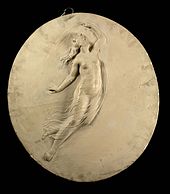William Henry Rinehart
William Henry Rinehart (born September 13, 1825 in Union Bridge , Maryland , † October 28, 1874 in Rome ) was an American sculptor.
Life
Rinehart was born to Israel Rinehart (1792-1871) and Maria Rinehart, née Snader, (1797-1865) near Union Bridge, Maryland, where he attended school until he was just under eighteen. He then started to work on his father's farm and became an assistant to a stonemason in the neighborhood. In 1844 he began an apprenticeship as a stonemason and studied sculpture at the Maryland Institute College of Art.
In 1855 he went to Italy to continue his studies. His first two works date from this time, two bas-reliefs in marble, " Morning " and " Evening ". Upon his return two years later, he opened a studio in Baltimore , where he created numerous busts and a fountain figure for the headquarters of the United States Postal Service in Washington, DC . Two bronze figures from this studio (" Pioneer " and " Indian ") flank the clock in the Chamber of Deputies of the Capitol in Washington.
In 1858 he settled in Rome, where he spent the rest of his life. Carrying out numerous assignments for wealthy and sophisticated clients resulted in Rinehart being financially successful in his life. These clients often visited him in Italy to discuss the planned projects for furnishing their goods with him. Rinehart's most important patron and sponsor was William Thompson Walters , the founder of the " Walters Art Gallery " in Baltimore, from which the Walters Art Museum emerged . He traveled to the United States twice, in 1866 and 1872, before he died in Rome in 1874. Rinehart is buried in Green Mount Cemetery , Baltimore.
estate
William Henry Rinehart bequeathed his estate to the private university Maryland Institute College of Art , which founded the " Rinehart School of Sculpture " in his honor and awards the Rinehart grant.
Works by Rinehart - mostly human figures in a classical style - are in public collections such as the Metropolitan Museum of Art , the National Gallery of Art , the Walters Art Museum, the Museum of Fine Arts, Boston , the Brooklyn Museum of Art , the Carnegie Museum of Art or the Columbus Museum of Art in Columbus .
Works (selection)
- Design for "Morning" and "Evening" (around 1856), plaster, ( Smithsonian American Art Museum )
- "Pioneers and Indians" (1858), bronze, monumental clock, (Chamber of Deputies of the US Capitol, now on display in the Capitol's crypt)
- "Sleeping Children" (1859), marble, Sisson's grave, (Green Mount Cemetery in Baltimore, Maryland)
- "Rebecca at the fountain" (1859 to 1861), marble, ( Corcoran Gallery of Art ), marble replica (1872) at the Metropolitan Museum of Art
- Bust of the wife of William Thompson Walters (1862), marble, (Walters Art Museum)
- "Hero" (1866), plaster, (Smithsonian American Art Museum)
- "Apollo and Diana" (1871–1872), plaster, (Smithsonian American Art Museum)
- Statue of Roger B. Taney (1887), bronze, (Mount Vernon Place in Baltimore), produced by the Royal Ore Foundry in Munich
literature
- A catalog of the work of William Henry Rinehart, Maryland, sculptor, 1825–1874 by Marvin Chauncey Ross, edited by the Board of Trustees of the Peabody Institute and the Walters Art Gallery (1948),
Web links
Individual evidence
- ↑ Rinehart on monumentcity.net, accessed on April 23, 2014
- ^ William Rinehart at findagrave.com, accessed April 23, 2014
- ↑ Biography in English accessed on April 23, 2014
- ↑ List of produced monuments
| personal data | |
|---|---|
| SURNAME | Rinehart, William Henry |
| BRIEF DESCRIPTION | American sculptor |
| DATE OF BIRTH | September 13, 1825 |
| PLACE OF BIRTH | Union Bridge , Maryland , USA |
| DATE OF DEATH | October 28, 1874 |
| Place of death | Rome |

